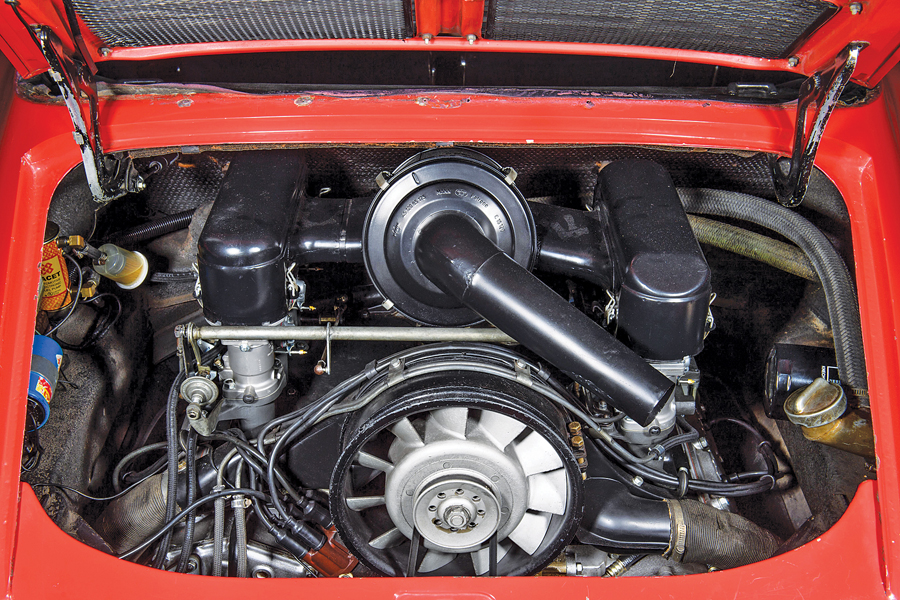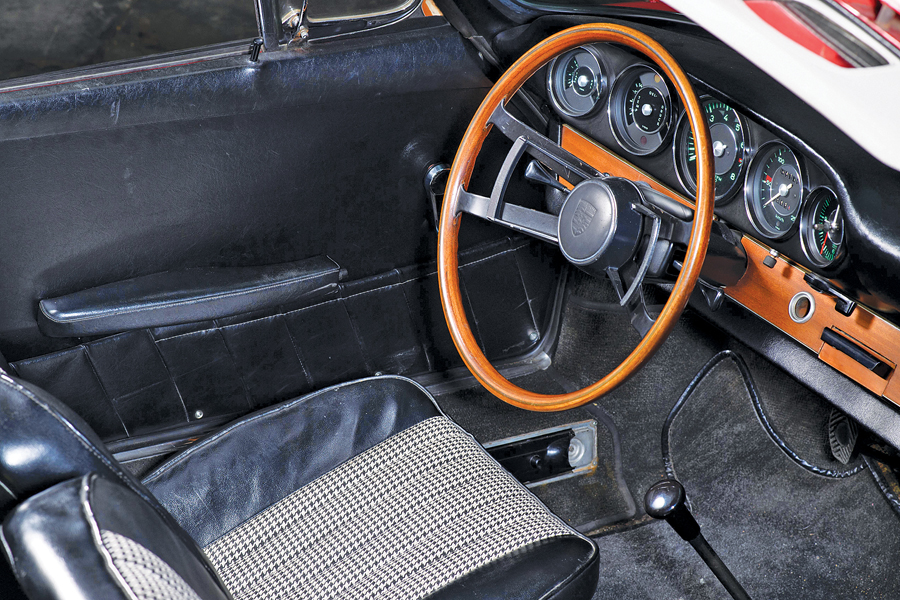- 30-bhp, 1,991-cc SOHC air-cooled, horizontally opposed 6-cylinder engine with Solex carburetors
- 5-speed manual transmission
- Independent front suspension with torsion bars and McPherson struts; independent rear suspension with torsion bars, trailing arms and tubular shock absorbers
- Four-wheel disc brakes
- Wheelbase 2,200 mm
- The only known 901 cabriolet prototype
- The oldest unrestored Porsche 901
- Largely original condition; documented history
- Shown at the Pebble Beach Concours d’Elegance
- Never before offered for public sale
SCM Analysis
Detailing
| Vehicle: | 1964 Porsche 901 Cabriolet Prototype |
| Years Produced: | 1964 Porsche 901 Cabriolet Prototype |
| Number Produced: | One cabriolet, 13 total 901 prototypes |
| Original List Price: | N/A |
| SCM Valuation: | $694,600 |
| Tune Up Cost: | $1,500 |
| Chassis Number Location: | Stamping above gas tank in trunk on passenger’s side |
| Engine Number Location: | Fan upright support, passenger’s side |
| Club Info: | Porsche Club of America; 232 Registry (first 232 901/911s, all 1964) |
| Website: | http://www.pca.org |
| Alternatives: | 1964 Porsche 901 2.0 coupe, 1963 Porsche 901 2.0 coupe prototype, 1967–68 Porsche 911R 2.0 coupe |
This car, Lot 159, sold for $692,798, including buyer’s premium, at RM Sotheby’s auction in Paris, FRA, on February 7, 2017.
So what’s disappointing about selling a car for $692,798? It’s a long story, but — of course — we want to tell it to you.
Just two Type 901 prototypes remain
It is well documented that Porsche built 13 Type 901 prototypes both before and after introducing the car at the Frankfurt Auto Show in September 1963. The cars were all numbered with five digits, and this auction car was 13360. The prototypes were used for different development projects — body, chassis, suspension, brakes, engines and such. Often, after one test was concluded, a car was used to test a different system.
Porsche’s cabriolet sales had been waning, especially in their primary market, the United States. They also feared that U.S. government regulations might move against open cars. More impactful was the advent of really workable air conditioning, which led even domestic manufacturers to abandon convertibles after the 1975 model year.
Of course, human nature prevailed, and as soon as convertibles were unavailable, the public wanted them. Convertibles eventually made a comeback, with Porsche joining in with their 911 SC cabriolet in 1983.
Second-guessing a convertible
In the late-1950s design specifications for the 901, Porsche management specifically excluded a convertible. In mid-1964, that decision was second-guessed when Porsche asked Karmann to chop the top off a prototype coupe. When the body maker returned the cabriolet body, it had no top mechanism. Porsche’s cabriolet specialist was supposed to add the top in Zuffenhausen. It appears that no real working drop top was ever installed, although several mockups were. Factory friend Manfred Freisinger is quoted as saying he got the car with an aluminum top but lost it when he moved his firm.
Porsche quickly realized that the huge hole left by cutting off the fastback roof also took away all passable chassis rigidity. The only solution was a roll cage, which Porsche quickly discarded. The 356 cabriolet had passed muster by being a chopped ”notchback,” which also gave rise to the 356 hard-top cabs and notchback coupes. Had Porsche tried to cut off the top of a fastback 356, it is likely similar problems would have been encountered.
This prototype gave birth to the Targa
The roll cage idea gave rise to the concept of just a roll bar holding the car together. That idea in turn led to the Targa, introduced for 1967, where a roll bar at the B-pillar was covered by a stainless-steel panel that connected the removable Targa top over the front two seats and a zip-out vinyl rear window. This was the so-called “soft-window” Targa. Starting in 1969, a glass “hard window” replaced the softie — although the latter remained an option into 1971.
Prototype 13360 quickly became an orphan, but one that survived — perhaps because it was unique, or perhaps it was just a quirk of fate.
Freisinger purchased the roofless prototype in 1966 and kept it for 35 years. In 2001, Myron Vernis of Akron, OH, traded a 356 Carrera 2 with a pushrod engine for the roofless 901. Myron is a well-known Porschephile who loves prototypes and orphans of all marques — but especially those with a Porsche connection. He cleaned the car up, rebuilt the “bitsa” engine with the correct specs and got the car running.
Shown at Pebble, but definitely not concours-level
Myron showed it frequently, including at Pebble Beach in 2013. It was not a concours car. In fact it was somewhat rough. On a prototype, we could argue that the patina is critical proof of the car’s history as a development mule. Restoration would destroy those remnants of its significant history.
The seats were not original, and the 4.5-inch Fuchs alloy wheels were reportedly added at the factory in 1966 as part of another testing program. Myron left the paint as he received it, in Signal Red, and he believed most of it might have been original.
The 901 prototype coupe serial number 13327
The only other surviving Porsche 901 prototype is the very-well-known coupe that belongs to Don Meluzio of York, PA. Its story has been written many times. It was the seventh prototype delivered, and it was used for suspension, brakes, aerodynamics and other development tests.
After a reported 44,000 km (27,340 miles), it was sold to Richard von Frankenberg, a Porsche employee, race car driver, Porsche factory magazine Christophorus editor, and author. Then the car was lost for years — until it showed up in the early 1980s at Paul Resnick’s Porsche Automobile Recyclers in Yonkers, NY. Considering the body damage, the asking price looked like much more money than the car was worth.
Many of us looked at it and demurred. Silly us.
Don Meluzio and Dennis Frick knew better, and Don bought it. Denny then restored the car. Almost nothing on the car, including its dimensions, matches a production 901/911. It has a 356 steering wheel, unique instruments first seen on the last 356 T7 prototype, a forward-opening sunroof, chromed brass trim, and many more hand-made deviations from a production 901/911. It is beautifully restored and has been at every major concours in the U.S. — often winning prestigious prizes.
What is 13327 worth?
I chat with Don about once a year about his 901 — recent shows, its ever-increasing value, how he does not want to sell it (probably ever) and such. My educated estimate is that the car would bring $4 million relatively easily, perhaps more — or even much more.
After Myron Vernis sold the prototype cabriolet to an English doctor who has a substantial car collection, the car came back on the market.
I had an email exchange about its sale with that owner. I believe that an offer well over a million dollars was sincerely extended. For the Paris auction, RM Sotheby’s estimated the 901 at €850,000–€1,000,000. The car hammered at just €580,000, or €649,600 after buyer’s premium, which translated to $692,798 on that date.
$692,798 vs. $4,000,000?
If Meluzio’s 901 coupe prototype is at least a $4 million car, how can the cabriolet prototype be worth just under $700,000? I am not that smart, but the guess is that the history of 13360 is considered to be less well developed.
That it was an abandoned concept probably does not help. The car’s condition also does not inspire a big expenditure. Nonetheless, the $692,798 was a surprise to us all. For a Porsche collection, it is an impressive focal point. We think history will show that the car was very well bought.
Note: Porsche built approximately 83 Type 901s before changing to “911,” after Peugeot noted their trademark in France for three-digit model designations with a zero in the middle. A special model name for cars shipped to France made no sense, so the Type 901 was called a 911 ever after. ♦
(Introductory description courtesy of RM Sotheby’s.)


